The AMD Radeon R9 290X Review
by Ryan Smith on October 24, 2013 12:01 AM EST- Posted in
- GPUs
- AMD
- Radeon
- Hawaii
- Radeon 200
GRID 2
The final game in our benchmark suite is also our racing entry, Codemasters’ GRID 2. Codemasters continues to set the bar for graphical fidelity in racing games, and with GRID 2 they’ve gone back to racing on the pavement, bringing to life cities and highways alike. Based on their in-house EGO engine, GRID 2 includes a DirectCompute based advanced lighting system in its highest quality settings, which incurs a significant performance penalty but does a good job of emulating more realistic lighting within the game world.
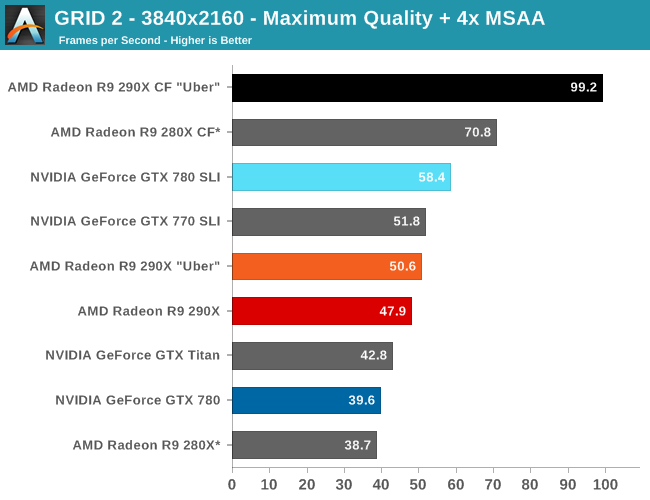
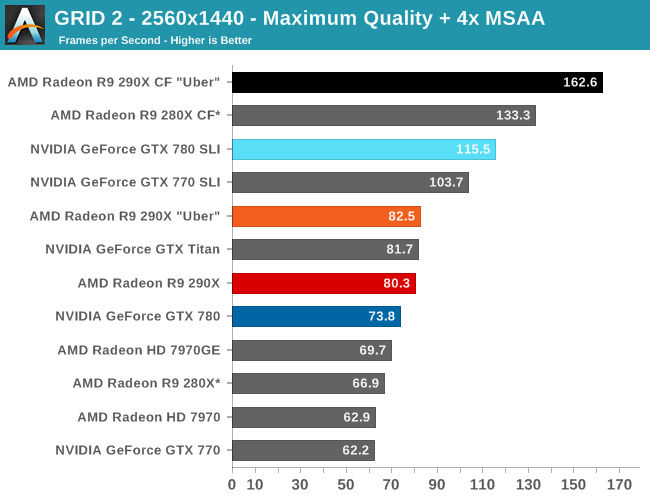
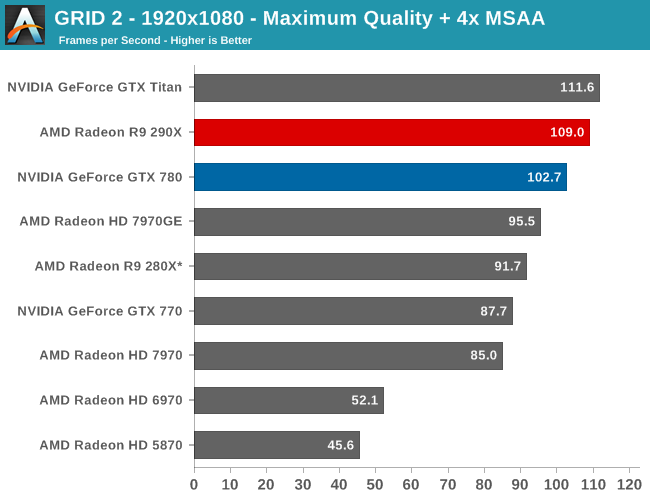
For as good looking as GRID 2 is, it continues to surprise us just how easy it is to run with everything cranked up, even the DirectCompute lighting system and MSAA (Forward Rendering for the win!). At 2560 the 290X has the performance advantage by 9%, but we are getting somewhat academic since it’s 80fps versus 74fps, placing both well above 60fps. Though 120Hz gamers may still find the gap of interest.
Moving up to 4K, we can still keep everything turned up including the MSAA, while pulling off respectable single-GPU framerates and great multi-GPU framerates. To no surprise at this point, the 290X further extends its lead at 4K to 21%, but as usually is the case you really want two GPUs here to get the best framerates. In which case the 290X CF is the runaway winner, achieving a scaling factor of 96% at 4K versus NVIDIA’s 47%, and 97% versus 57% at 2560. This means the GTX 780 SLI is going to fall just short of 60fps once more at 4K, leaving the 290X CF alone at 99fps.
Unfortunately for AMD their drivers coupled with GRID 2 currently blows a gasket when trying to use 4K @ 60Hz, as GRID 2 immediately crashes when trying to load with 4K/Eyefinity enabled. We can still test at 30Hz, but those stellar 4K framerates aren’t going to be usable for gaming until AMD and Codemasters get that bug sorted out.
Finally, it’s interesting to note that for the 290X this is the game where it gains the least on the 280X. The 290X performance advantage here is just 20%, 5% lower than any other game and 10% lower than the average. The framerates at 2560 are high enough that this isn’t quite as important as in other games, but it does show that the 290X isn’t always going to maintain that 30% lead over its predecessor.
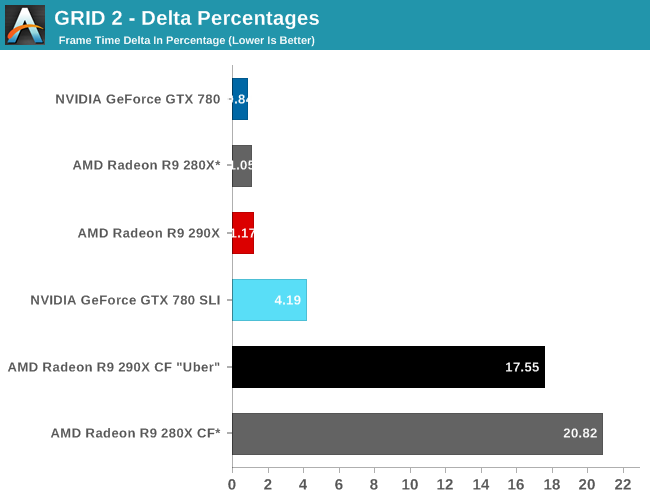
Without any capturable 4K FCAT frametimes, we’re left with the delta percentages at 2560, which more so than any other game are simply not in AMD’s favor. The GTX 780 SLI is extremely consistent here, to the point of being almost absurdly so for a multi-GPU setup. 4% is the kind of variance we expect to find with a single-GPU setup, not something incorporating multiple GPUs. AMD on the other hand, though improving over the 280X by a few percent, is merely adequate at 17%. The low frame times will further reduce the real world impact of the difference between the GTX 780 SLI and 290X CF here, but this is another game AMD could stand some improvements, even if it costs AMD some of the 290X’s very strong CF scaling factor.


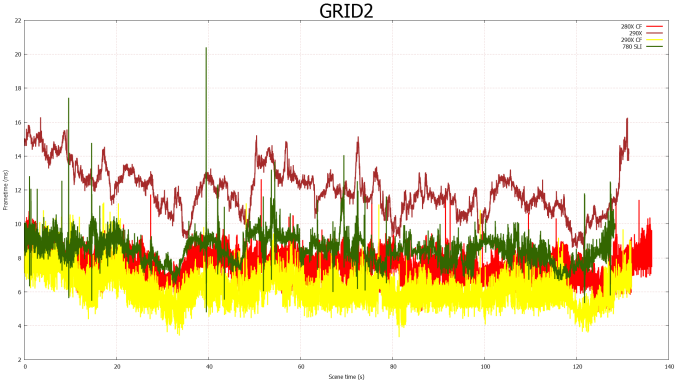








396 Comments
View All Comments
AtwaterFS - Thursday, October 24, 2013 - link
Nice, Nvidia has two choices, drop prices substantially, or drop trou.I certainly hope its the former, as I have no interest in seeing Jen-Hsun's pig in a blanket...
Wreckage - Thursday, October 24, 2013 - link
Not really the Titan slayer we were hoping for.After all this wait and hype it's not surpassing last years GK110. I guess we don't look for big gains in new chips anymore.
The Von Matrices - Thursday, October 24, 2013 - link
This is on the same process node as Titan. Big advances don't happen without process node shrinks, regardless of manufacturer.ninjaquick - Thursday, October 24, 2013 - link
A million times this... GCN is superior to Kepler, and probably Maxwell as well. It doesn't waste tons of die-space on large cache/special decoders/legacy bullshit. Game creators want massive arrays of simple math units that can voraciously crunch numbers, and that is what GCN delivers.EJS1980 - Thursday, October 24, 2013 - link
"GCN is superior to Kepler, and probably Maxwell as well"...HEHEH..... THIS IS PRETTY FUNNY, MAN......THANKS.....I NEEDED THAT! :PWill Robinson - Thursday, October 24, 2013 - link
Yeah right Wreckage...only slayed Titan by about $500 LOLIdiot.
chizow - Thursday, October 24, 2013 - link
Great price and performance from AMD without a doubt, it's not quite a clean sweep but it is certainly a convincing victory for R9 290X, especially at higher resolutions. 780Ti may come close or even exceed 290X, but the damage to Nvidia's product stack has been done.The symmetrical irony here is that this generation's price escalation that began at $550 with AMD's first 28nm part, Tahiti, has come full circle and brought back to balance with AMD's last 28nm part, Hawaii, again at that $550 price point.
I'm happy to see some balance back in the GPU market though, I stated this month's ago at 690 and Titan launch, that this $1K pricing model was an unsustainable business strategy for Nvidia. Now it's going to bite them squarely in the ass. They'll now reap what they sow and have to deal with the angst and anger from all of their most loyal fans who will undoubtedly feel as if they were cheated by the 690, Titan and even 780.
chizow - Thursday, October 24, 2013 - link
I guess it couldn't be all good news though, it looks like the leaked thermals, power consumption and acoustics weren't exaggerated. Definitely loud and hot, with high operating temps. I guess AMD really pushed the GPU to the max, I doubt there will be much more OC headroom, at least with the reference cooler.If Nvidia wasn't so greedy with 690/Titan/780 pricing 290X might've been the next Fermi with mixed reactions, but I'm sure the price and performance will overshadow heat/power concerns.
t41nt3d - Thursday, October 24, 2013 - link
NVIDIA won't be bitten in the ass at all due to the prices of the 690s and Titan. A god awful amount of people have paid $1000 (Including me) for one or more of these cards, and it's taken /8 Months/ for AMD to release a card that goes back and forth with the Titan - Doesn't outright beat it in some games, can go either way.NVIDIA have made a crapload of money from their two overpriced cards and have been reaping off this for a long time now, all they need to do is lower prices and no money lost. It's AMD who's been letting them get away with those prices for so long.
It seems a perfectly viable business strategy for them to have done what they've done and to be so successful at it.
chizow - Thursday, October 24, 2013 - link
I guess we will see, their job just got that much harder to try to sustain this $1000 pricing model now that a $550 card now matches and sometimes outperforms their $1000 card. What kind of performance do you think they're going to need next time to try and justify a $1000 pricetag?Again, Nvidia went down the path of an unsustainable business model predicated on the fact they would be an entire ASIC ahead of AMD. That lead was clearly short-lived due to Kepler's excellent overall performance, but Hawaii brought that dream back down to reality. Sure a bit late, but still in time to crash Nvidia's $1K parade.